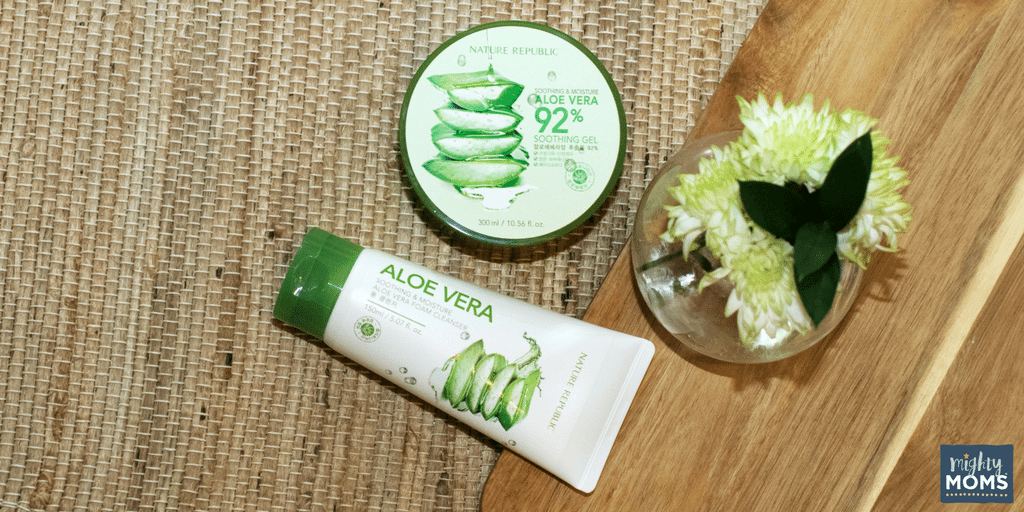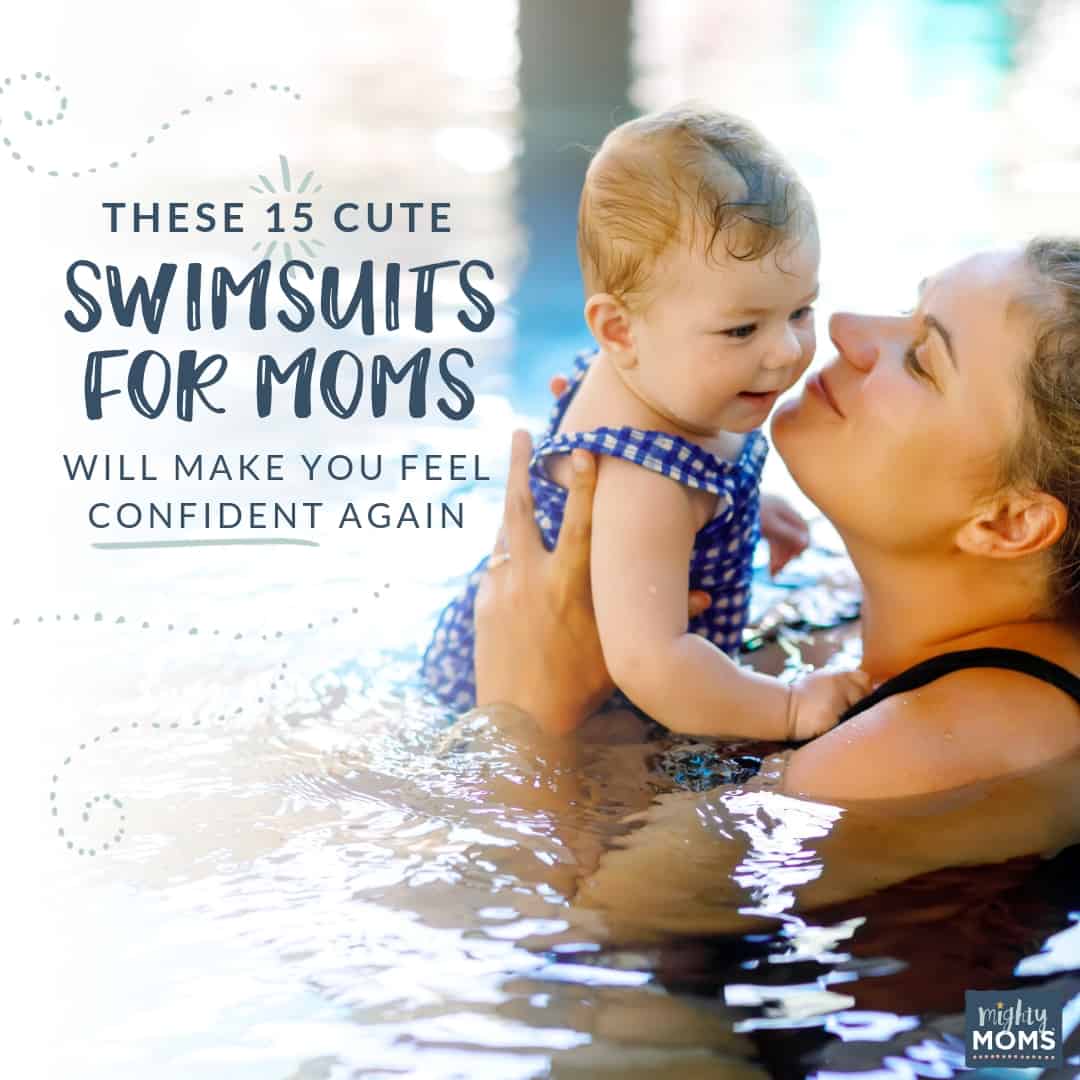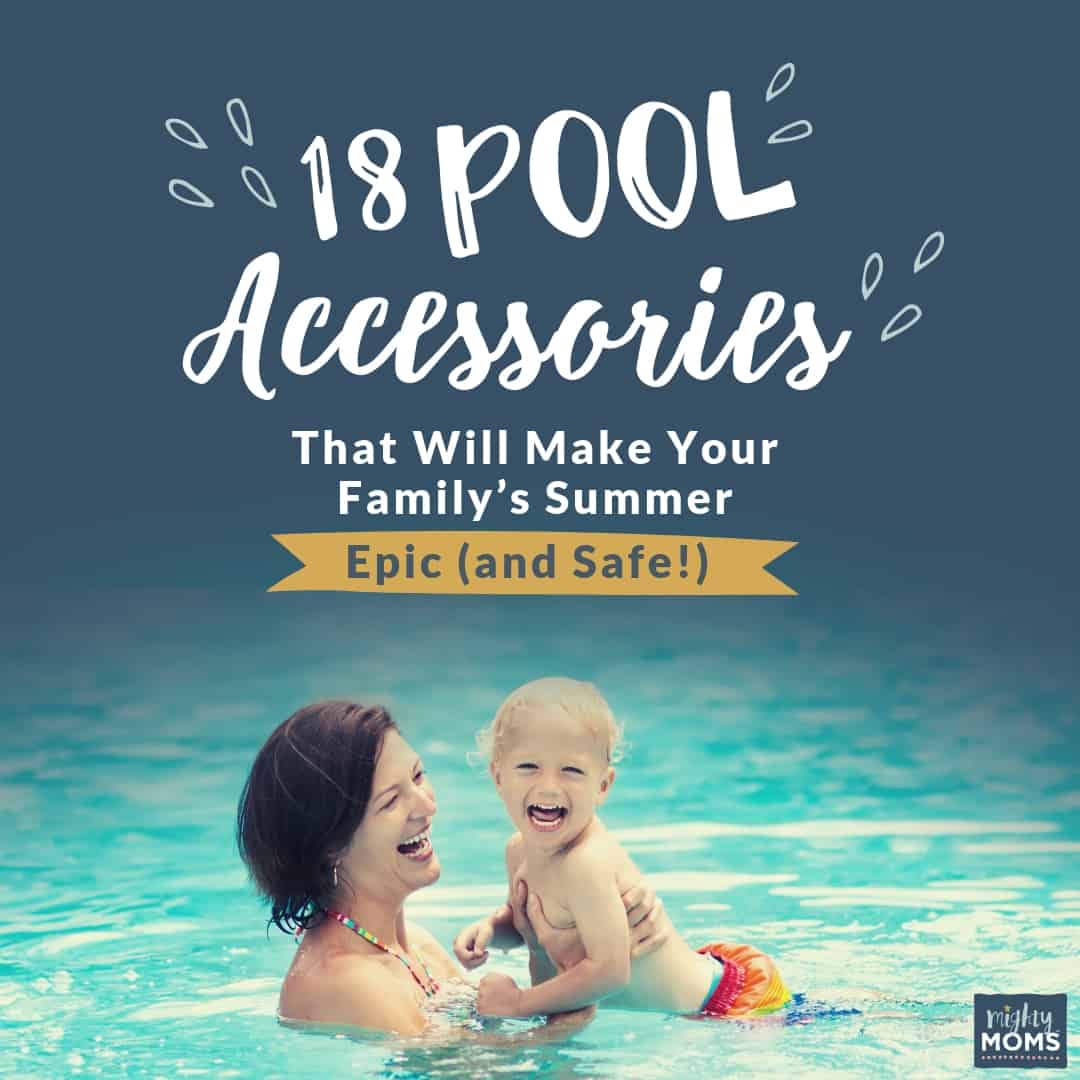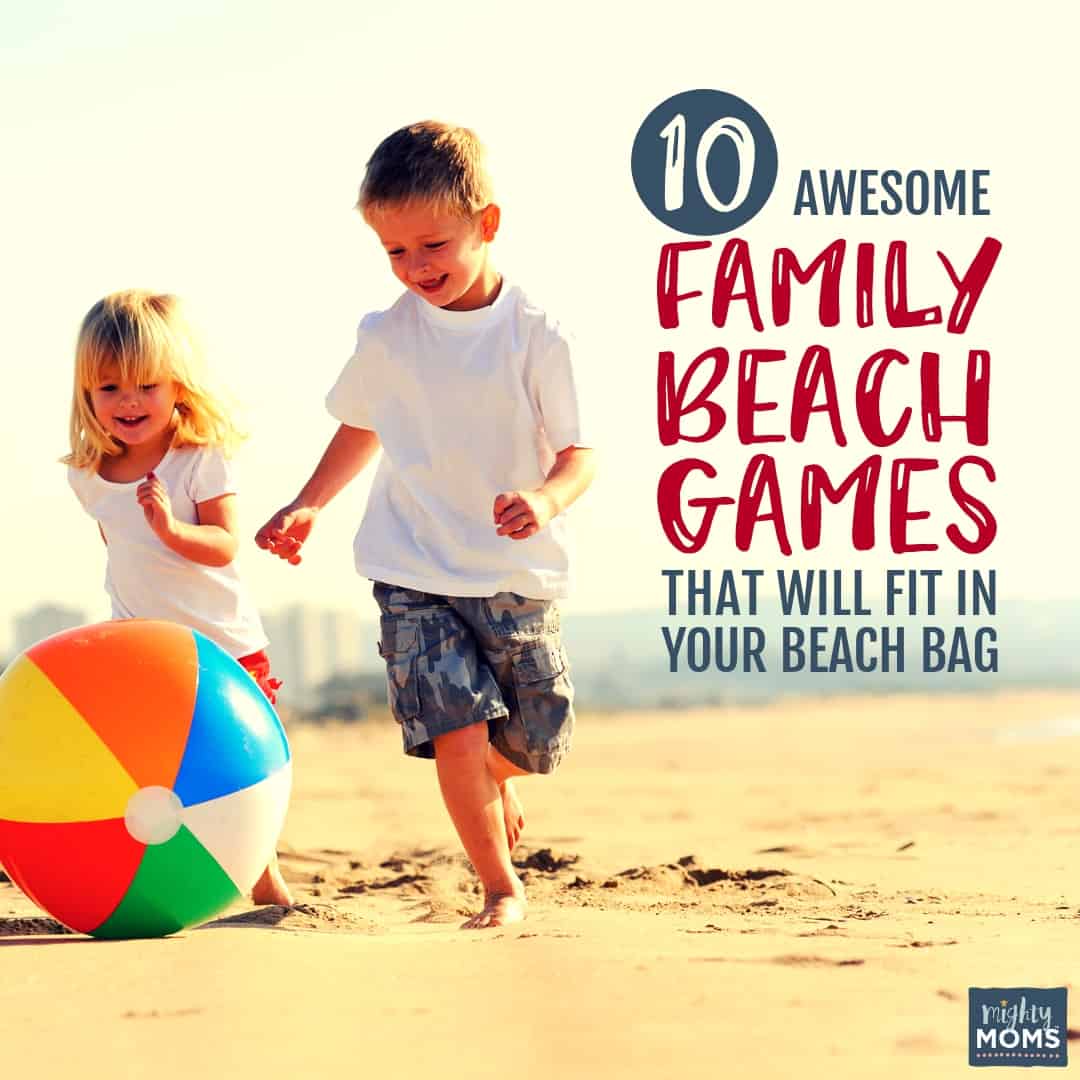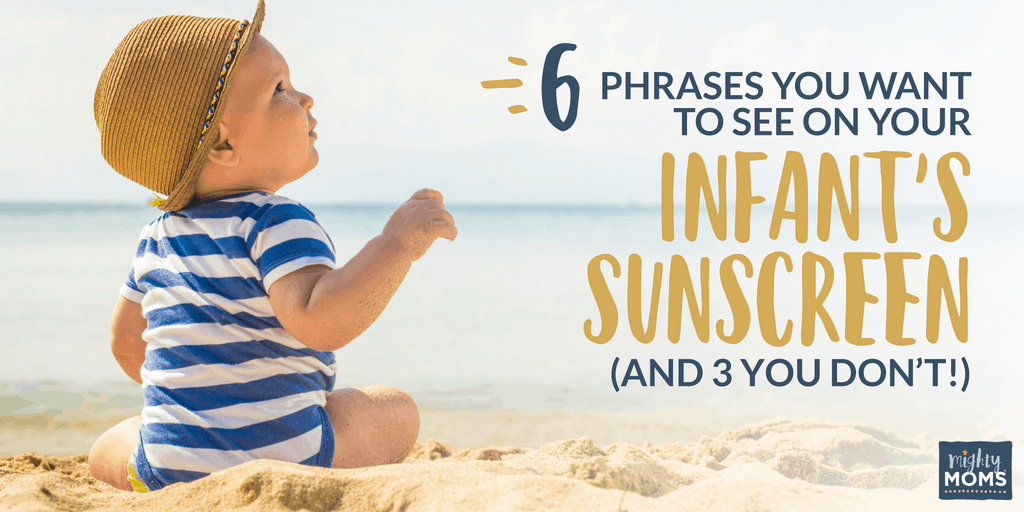
I’m not a big “Let’s Freak Out Over Nothing” kind of mother. Sometimes, though, a few horns need to be honked.
Check out what the Skin Cancer Foundation says…
- Just ONE blistering sunburn in childhood more than doubles a person’s chances of developing melanoma later in life.
- 22% of all children will get a sunburn in their first summer of life.
- 45% of all children will get a sunburn in their second summer of life.
For those of you playing along, that means that 67% of all children in the US will have experienced a sunburn before the age of 3. A sunburn that will more than double their chances of getting skin cancer later as an adult.
Yowzers. Not cool. It leaves me flabbergasted. (And a little paranoid about sun safety. ???? )
So what’s a mom to do? Start a Hermit colony at home and stare out the window knitting until your baby is past the 6-month mark?
PISH POSH APPLESAUCE.
You’ve got stuff to do.
Instead of being stuck at home working through Knitting with Dog Hair or Crafting with Cat Hair, let me offer a few suggestions on how to get you and your baby safely out of the house.
Let’s start with newborns, since they’re at the biggest risk. (Don’t have a newborn? Skip all that.)
Cheat Sheet for Taking Newborns Outdoors
To make it even worse (because why not?), if your baby is less than 6 months old (i.e. a newborn) you’ve got to be extra-specially careful with the sun.
- Newborns have sensitive skin. Using a normal store-bought sunscreen on a newborn increases your baby’s chances of having a reaction.
- The “surface area of skin” to “body weight” ratio is much higher in infants. This means that the chemicals in sunscreen have that much more opportunity to be absorbed into the bloodstream.
- They have a lot less melanin. Melanin is the skin pigment that gives color to skin, hair, and eyes and provides some measure of protection. Without this natural protection they are quite vulnerable to Mr. Sun’s damaging effects. (BTW, it doesn’t matter how dark-skinned your baby is.)
#1) Timing is Everything
Run errands, take your walks, garden, and meet friends for an alfresco cappuccino with your newborn in the car seat.
Just do it before 10 a.m. or after 2 p.m. Basically, avoid the midday sun when the UV rays are strongest. Click here for an instant UV check of what the index is in your area today.
#2) Dress (Your Newborn) for Success
Dress your infant in clothing that covers his limbs. Be sure it is lightweight (when warm outside) but tight-weave so it really blocks those pesky UV rays. This sunsuit will cover all your bases.
#3) Parasol Your Prince or Princess
Give your newborn the royal treatment by making sure that he is constantly covered by something. Use an umbrella of some sort on your trips outdoors and bring that shade with you wherever you go. Better yet, use a portable UV-protective sun bed like this one. It’s handy outside AND indoors for Grandma/Grandpa trips and July 4th picnics!
#4) Discover the Wonders of a Wide-Brimmed Hat
Bonnets are cute, but they’re not much use against the UV Monster. Look for a sun hat with a wide-brim that will cover the head, neck, and ears. This hat-style is an adorable blend of all the coverage your infant needs.
#5) Tint Those Windows Like a Boss
If you’re going to be traveling for any length of time, help your baby out by putting a tint on the back windows, or at least using a really great window shade. That particular window shade is a favorite because…
- It fits around the entire door, so you don’t have to mess with those *bleep* suction cup window shades.
- You can roll down the window and still shade your baby—so if you’re trying to keep him awake for naptime, or to distract him from crying, the ‘ole “magic window trick” can still be used! *highfive*
Okay, so we’ve covered the newborns. Now it’s time to address all the other babies out there. The ones that need a natural infant sunscreen that actually works.
Your Free Cheater’s Cheatsheet
Before we dive in, I thought it might be handy to create something you can stick into the diaper bag as a reference guide.
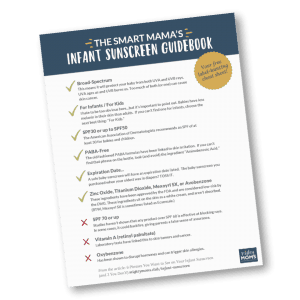
Why is that a direct link and not behind a give-me-your-email wall? Because I don’t want to bully you into a friendship.
If you like the free download, why not subscribe to my weekly email and get a free copy of 101 Ways to Be an Awesome Mom?
Or, if you’re grateful, but not interested in subscribing, can you share this article with your social media pals? That works too!
From one working mother to another, thanks!
I Spy…
6 Words You WANT to See
On Your Infant Sunscreen Label
Firstly, I should start out with an apology. I’m about to mislabel something. Technically, the items I’m sharing here would be considered sunblock and not sunscreen.
Sunblock is something that sits on your skin, blocking it from the sun’s rays. Sunscreen is something that is absorbed into your skin, like sand going through a screen.
Those are the technical “correct” terms to use with these things…but frankly I don’t know anyone this side of the Atlantic who is going to say “I need to get some baby sunblock!” so I’m going to be a poor educational example and incorrectly use term “sunscreen” instead.
Don’t sue me. I’m a victim to cultural colloquialisms.
The Magical Phrases You’re Searching For
Here’s a short list of the keywords and phrases you want to see on your kid-friendly sunscreen. Don’t panic if you don’t see them all, just shoot for most. (You can get all this on a free label cheat sheet at the bottom of this article.)
- Broad-Spectrum ~ This means it covers UVA and UVB rays.
- For Infants / For Kids ~ Children have less melanin in their skin than adults, so they need more protection than we do.
- SPF 30+ ~ The higher the SPF, the more sun protection the sunscreen has. Do a search for “Today’s UV Index” to find out how much protection you need on any given day.
- PABA-Free ~ the old fashioned PABA formulas have been linked to skin irritation. If you can’t find that phrase on the bottle, look on the ingredients list. Aminobenzoic acid is PABA, so do a happy dance if it’s NOT printed there.
- Expiration date… ~ Yes, a safe infant sunscreen will have an expiration date listed. The sunscreen you purchased when your oldest was in diapers? TOSS IT. (Me? …a hoarder? Never!)
- Zinc Oxide, Titanium Dioxide, Mexoyrl SX, or Avobenzone ~ These are active ingredients the FDA recommends for a safe infant sunscreen.
Just so you’re aware, these infant sunscreens are going to feel a little different than perhaps what you’re used to. The active ingredients (zinc oxide, etc.) sits on the skin, rather than getting absorbed into it. This can confuse first-time users, who are expecting it to magically disappear.
…With My Little Eye…
3 Phrases You DON’T Want to See
on Your Infant Sunscreen Label
Here are the things you DON’T want to see on your baby’s sunscreen label.
- SPF 70 ~ Studies haven’t shown that any product over SPF 60 is effective at blocking rays. In some cases, it could backfire, giving parents a false sense of assurance.
- Vitamin A (retinyl palmitate) ~ laboratory tests have linked this to skin tumors and cancer.
- Oxybenzone ~ disrupts hormones and can trigger skin allergies.
These are no-no’s on ANY sunscreen, honestly, but definitely something you want to avoid using on your kids!
Heather’s Top Infant Sunscreen Picks
I hear your brain working…albeit a little slower than usual. (You’re tired, I get it!)
Sure, I’ve given you a sunscreen label cheat sheet, but sometimes it’s easier to just have someone TELL YOU which infant sunscreens have the “right stuff”, you know? Take one more thing off your to do list.
Here are top infant sunscreens that pass all my strict label tests:
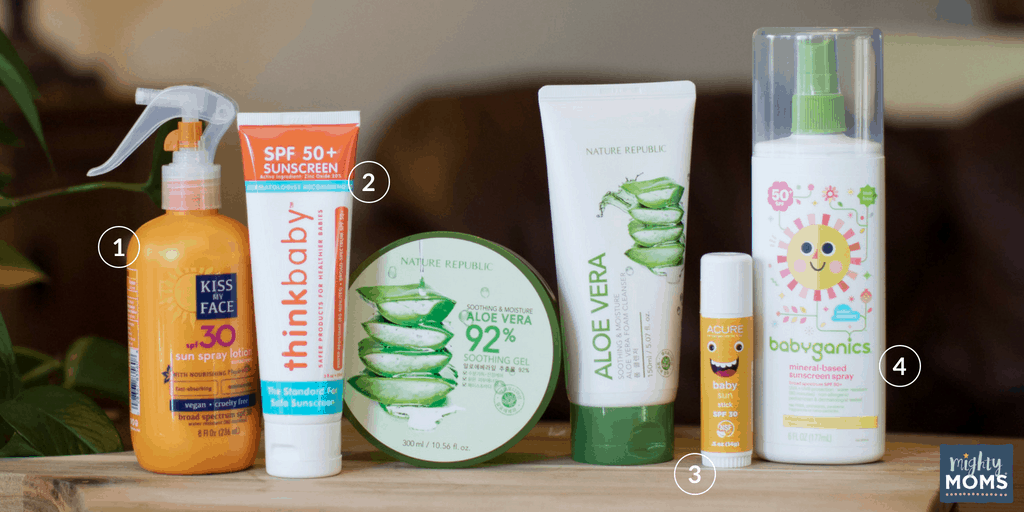
1. Kiss My Face Sun Spray | 2. ThinkBaby Infant Sunscreen
3. Aucre Organics Sun Stick | 4. Babyganics Sunscreen Spray
Why You Need Aloe Vera
in Your Medicine Cabinet
I realize it may seem a little random to be suddenly talking about aloe vera in an article about infant sunscreen…but bear with me. They actually are related.
At some time, you’re going to head home after a day out and about, and realize with horror that some portion of your child’s skin was missed in the application process and raw, red skin is starting to flame up.
DON’T PANIC. We’ve all been there. Don’t beat yourself up. This is fixable.
Pull out the aloe vera soothing gel from your medicine cabinet (which will be there because you’re reading this). Here’s why…
- It feels amazing. It’s instantly soothing. (Talking from experience here, people.)
- The American Academy of Dermatologists recommends using it for sunburns.
- Amazon has it for super cheap: $7.10
- Use this aloe vera cleanser during bath time (avoid the eyes!) to avoid irritating the skin any further and help speed the healing process along.
Trust me, this is something that you don’t realize how desperately you need it until you REALLY NEED IT. Pick it up now and thank yourself later.
Go Forth and Sun in Confidence
How are you feeling about your sun adventures, then? More confident?
Let’s go through a little checklist to see how prepared you are to protect your child from the evils of Sinister Sun:
- You know how to read the infant sunscreen labels. (Not 100% sure about this one? No prob, Bob. Just use the free printable at the top of this article.)
- You’ve stocked up on a good spray infant sunscreen, a sun stick, and a lotion.
- You’ve got an aloe vera soothing gel on the way for any sunburn whoopsies.
Looks like you’re all set! All you need now is to remember to bring them to the beach… 🙂
Have You Read These Yet?
We ♥ honesty! This post contains affiliate links that provide extra money for our mutual coffee habits addictions. Click here to learn more. As an Amazon Associate I earn from qualifying purchases.
